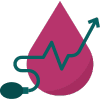.png?width=484&height=484&name=Green%20and%20Gold%20Professional%20Business%20Woman%20LinkedIn%20Profile%20Picture%20(4).png)
In the ever-changing world of healthcare, increasing clinical capacity has become a priority for many health systems. Patients are aging, with many developing chronic conditions that drastically increase the need for quality care. With rising patient demands, improved care delivery is paramount to effectively managing the patient population; however, this challenge poses the risk of increasing capacity without driving impact, resulting in significant financial strain. Fortunately, there are several strategies that can enhance clinical capacity while considering financial constraints.
At Greater Good Health, we’ve perfected the balance between expanding clinical capacity and maintaining cost-effectiveness. This blog article explores practical and innovative approaches to achieve this balance.
Here’s a closer look at strategies to boost clinical capacity and lower care cost:
Virtual Care: Expanding Reach of Clinical Services
Telehealth has been a revolutionary tool for healthcare because it allows clinicians to provide medical services in a timely and efficient manner at a lower cost while also improving access for patients. Patients can connect to providers quickly through the click of a button from qualified providers all over the world without leaving the comfort of their home. Successful telehealth requires 3 Ps: the right patient, purpose, and provider. Not all patients are equipped with technology and equipment; not everything can be addressed or resolved for in a virtual visit, sometimes an in-person assessment is necessary; and not all providers or procedures can satisfy their needs through technology interfaces. However, for a subset of situations, a telehealth visit can create capacity for busy providers and can be helpful in preventing unnecessary trips to urgent care or the emergency room or replace a simple in-office visit.
Benefits of telehealth include:
- Improved Access to Care: Telehealth bridges gaps in access to care, particularly for patients that are geographically constrained and do not have access to care within their area (such as rural areas or clinical care deserts). By increasing access for patients in medically underserved areas through telehealth, patient outcomes can be drastically improved through timely and effective management.
-
Care Coordination: Often times patients need touchpoints between office visits to ensure they stay on track with their care plan and medications. Virtual visits are a cost and time effective way to do this.
-
Patient Satisfaction: For seniors who find it difficult to travel into the clinic for an in-person visit, virtual visits could be less disruptive to their day, reduce the risk of falls, and dependency on caregivers to assist with travel and transportation. Some studies find that patient experience is improved when telehealth visits are offered as a supplement to office visits.
- Potential Cost Savings: Besides saving on provider travel time, reimbursement, and other administrative cost associated with in-person visits, the improvement in productivity and capacity allows providers to focus on patients.
At Greater Good Health we incorporate telehealth into our care model, allowing our nurse practitioners to serve a wider patient base efficiently. By using telehealth solutions, we reduce unnecessary in-person visits while ensuring patients receive timely consultations, improving access and lowering costs.
Tips to Implement Telehealth
To successfully implement telehealth visits and utilize their benefits, organizations should:
-
- Invest in a reliable electronic health record system (EHR) that can successfully integrate with other platforms. Choose a HIPAA-approved system that is user-friendly for both patients and providers and can provide benefits for all disciplines within your organization.
- Train staff effectively to use telemedicine tools. Ensure that they have an advanced understanding of the platform in the event they need to troubleshoot technology issues with patients and that telemedicine is effectively woven into clinical workflows. Document all training materials and archive any lectures/videos.
- Promote adoption by educating patients about the ease, effectiveness, and availability of telehealth. Ensure patients understand that telehealth visits are available at your organization and may provide additional benefits as opposed to a face-to-face visit.
Optimizing Workflows
To manage an increase in clinical capacity, it is imperative to develop workflows that save time and increase efficiency. This will often involve streamlined processes with the help of technology and knowledgeable and collaborative clinic staff that can effectively deliver care in an efficient and timely manner without sacrificing the highest standards of quality.
- Standardize Procedures: Create standardized procedures that will allow team members to work efficiently while minimizing errors and variability in work. Standard procedures can include how-to guides/job aids, standard operating procedures, employee handbooks, or daily huddles.
- Utilize Technology: Technology has helped practices become more efficient through the creation of online scheduling, digital documentation in EHR systems, and the ability to share and communicate knowledge with others inside and outside of your organization. Using technology to save time on repetitive tasks such as order forms, intake forms, and chart notation will help to improve quality and reduce administrative burden and errors.
- Continuous Improvement: This is an important part of the culture, encouraging teams to develop an on ongoing effort to improve a process, product, or service by removing waste and enhancing activities that add value.
-
Performance Management: Leaders must develop processes to ensure actions and activities are getting done in order to achieve the goals and outcomes.
At Greater Good Health, we work every day to improve efficiency and streamline workflows and also ensure high-quality care without increasing the administrative burden on providers. Our systems are designed to save time, enabling our team to focus on delivering patient care.
Tips to Implement Efficient Workflows
To maximize your clinical capacity with efficient workflows, organizations should:
-
- Have resources available to all team members to troubleshoot, report, and manage any technology roadblocks.
- Recorded lectures, educational materials, or personal training are examples of ways to help team members feel more comfortable leveraging technology for workflow enhancement
- Use effective, timely, and clear communication to participate in continuous improvement and implement changes to workflow. Ensure team members have an outlet for feedback and check in regularly to monitor adoption
- Encourage staff to engage in continuous improvement leveraging methodologies such as Plan-Do-Study-Act (PDSA), Lean, and Six Sigma.
Leveraging NP-Based Care Teams
Nurse practitioners (NPs) have been proven to deliver quality care comparable to that of physicians at a much lower cost [1]. Nurse practitioners are currently being utilized more than ever to address the gaps in primary care and meet growing patient demands. By leveraging the expertise of nurse practitioners, healthcare organizations can maintain the quality and integrity of the care delivery model while keeping additional costs low.
- Holistic Care: Nurse practitioners focus on treating patients holistically, aiming to take a wider approach to addressing patient needs without solely focusing on a patient’s physical health. Nurse practitioners will examine a patient’s mental, emotional, and spiritual health, identifying any care gaps and providing patients with additional resources to resolve these care gaps.
- Resolve Physician Gaps: The Association of American Medical Colleges reports that the U.S. could experience a physician shortage of “37,800 and 124,000 physicians by 2034” [2]. With the growing shortage of physicians, nurse practitioners are being utilized more than ever to fill in gaps, ensuring all patients receive quality, timely care.
-
Alignment to Value-Based Care: NPs are trained to implement treatment plans, ensuring patients are taking their medications, understanding their instructions, coordinating their next provider visits, and making the necessary lifestyle changes to improve their health. These are the actions and activities that will move the needle on many of the value-based quality-focused outcomes that organizations demand to see.
-
Encourage Team-Based Care: Inherently, because they come through nursing training, NPs embrace team-based care and very skilled at working collaboratively with other specialists, providers, and roles in shared accountabilities, documentation, and follow-up. Team-based care is becoming more and more essential as we continue to see a shortage in the healthcare workforce.
-
Patient Acceptance: Year over year, we see an improvement in the public’s perception of a Nurse Practitioner. Especially in areas where there is a physician shortage, patients are no longer concerned or bothered by the misconceptions of lower quality or caliber of care provided by an NP (or anyone other than an MD). Studies show that NPs score higher on patient satisfaction [3].
Greater Good Health’s focus on building NP-based teams empowers nurse practitioners to take a more active role in patient panel management, addressing a patient's physical, emotional, and mental health. By expanding the responsibilities of NPs, we resolve physician shortages and reduce costs, all while maintaining high levels of patient satisfaction. Our holistic approach, driven by nurse practitioners, ensures that patients receive care beyond clinical needs. Our NPs identify and address psychosocial and environmental factors that affect patient health, leading to better overall outcomes and reduced reliance on expensive interventions.
Tips for Building Effective NP-Based Teams
To leverage benefits from NP-based teams, organizations should:
- Clarify Roles and Responsibilities: Ensure nurse practitioners are aware of their role, scope, and what tasks are allocated to them. Provide clarity with verbal and written communication about work tasks and responsibilities. Design workflows to allow nurse practitioners to practice at the top of their license to keep them engaged and inspired by their work.
-
Proper Clinical Oversight & Coaching: NPs like other clinicians need a network of other providers to support their practice of medicine. Working closely with physicians for oversight, auditing, review, coaching, and training will strengthen NPs’ decision-making, clinical rigor, and self-confidence.
- Support Professional Development: Empower nurse practitioners through provision of professional development opportunities such as continuing education, professional conferences, training, and education reimbursements. Professional development will help NPs stay up to date with skills and requirements, ultimately strengthening overall care and outcomes.
Conclusion: Boost Clinical Capacity the Cost-Effective Way!
Boosting clinical capacity without breaking the bank does not have to be an impossible task for healthcare organizations. At Greater Good Health, we partner with organizations across the country to provide patients with comprehensive, value-based care for markets plagued by physician shortages. We have a highly trained team of experienced Nurse Practitioners with over 100,000 patients under management, allowing our partner organizations to meet growing patient needs while keeping costs low. Through these innovative strategies, we provide our partner organizations with a scalable, cost-effective way to expand clinical capacity, improve patient outcomes, and reduce unnecessary healthcare expenditures.
Ready to improve your care delivery and patient outcomes? Contact us today, our proven methods can help your organization expand capacity, increase efficiency, and drive sustainable growth.
Why Choose Us?
At Greater Good Health, we are committed to helping organizations navigate the complexities of managed care. Whether it's boosting clinical capacity, optimizing risk adjustment, improving quality performance, or enhancing HCC coding practices, we bring innovative solutions designed to drive real impact.
Our approach is rooted in deep clinical expertise, advanced analytics, and a commitment to patient-centered care. We work closely with our partners to implement solutions that are not only effective but also sustainable, helping you to thrive in a value-based care environment.

500 +
Clinical Practices Supported

20000 +
Patients Under Management

25 %
Reduction in 30-day Readmissions

38 %
Patient Engagement Rate

